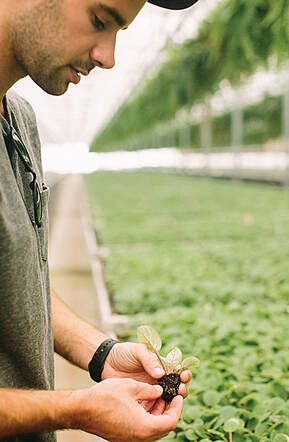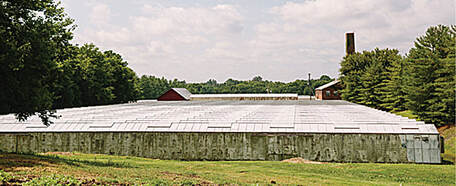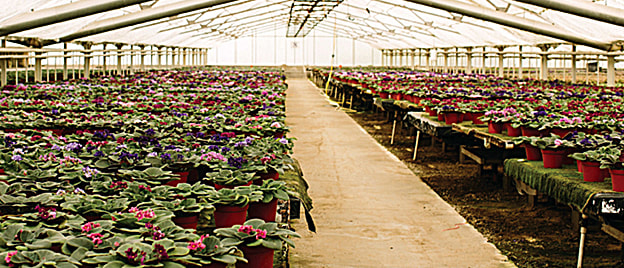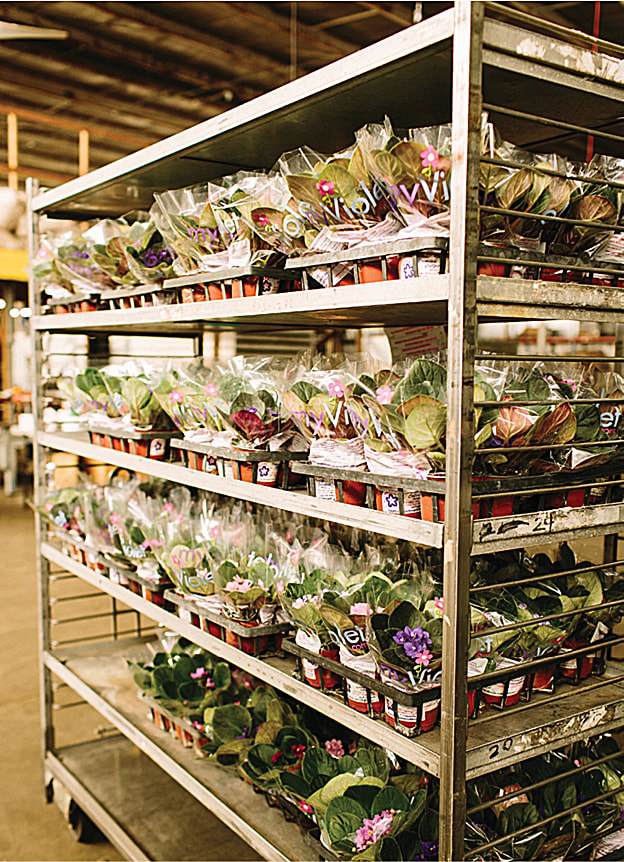Meet the Holtkamps
|
You've Probably Grown Their Violets
Reproduced, with permission, from Greenhouse Management magazine. The story was written by Chris Manning and the photographs are by Rachel Moore |
|
With five generations of growing tradition behind it, Holtkamp Greenhouses has become the largest producer of African violets in the world.
|
|
To understand Optimara today, you have to go back to the early 1900s.
In 1904, Martin Dorrenbach founded his greenhouse in the lower valley of Germany. By the beginning of the 1930s, Dorrenbach’s son-in-law, a horticulturist named Hermann Holtkamp, bred his first variety of African violets. After World War II, Hermann bred several varieties and was recognized in 1952, winning a gold medal at the Bundesgartenschau Flower Exhibit in Germany for a violet named after Dorrenbach. By the 1960s, Hermann and his team developed the first non-dropping African violet. |
|
Today, across the Atlantic Ocean near Nashville, Tennessee, the spirit of innovation still drives Holtkamp’s descendants to develop the next generation of African violets. Under the Optimara brand — grown at Hermann Holtkamp Greenhouses, a homage to Hermann and the largest greenhouse-produced African violets in the world — Herrmann's grandson Reinhold Holtkamp and his son Lawrence work with family still living in Germany to breed and grow the next industry-standard African violet.
At the same time, under Lawrence’s guidance, Optimara is investing in new retail markets aimed at getting a new generation of customers purchasing African violets. |
|
“My grandfather always said that the African violet is the potted plant of the future,” Reinhold said.
Establishing a foothold Reinhold grew up around African violets. Before emigrating to the United States in 1980 at 17 years old, he grew up in Germany working with his father, Reinhold Sr., and learned from him as he prepped for his own greenhouse career. In 1977, Reinhold Sr. purchased the Joy Floral greenhouses in Tennessee and started the process of moving his family to the United States. The business had come on the family’s radar through a contact at the U.S. Department of Agriculture. “It was a hard beginning because it was a dilapidated greenhouse facility when we started. It was 250,000 square feet when we started and three years into the effort, we went down to 100,000 square feet. I told my dad that we were going the wrong way,” Reinhold says with a laugh. According to Reinhold, the move to America was something Reinhold Sr. had been exploring since a visit to the U.S. in the late 1950s, and he wanted to be somewhere where he could reach customers within 600 miles. |
|
|
The business had come on the family’s radar through a contact at the U.S. Department of Agriculture.
“It was a hard beginning because it was a dilapidated greenhouse facility when we started. It was 250,000 square feet when we started and three years into the effort, we went down to 100,000 square feet. I told my dad that we were going the wrong way,” Reinhold says with a laugh. According to Reinhold, the move to America was something Reinhold Sr. had been exploring since a visit to the U.S. in the late 1950s, and he wanted to be somewhere where he could reach customers within 600 miles. “Dad was always a pioneer,” Reinhold says. “He was never resting.” Reinhold had come for a year in 1977 but returned to Germany to finish his pre-university education. In 1980, Reinhold emigrated to the U.S. to start his studies at Vanderbilt University pursuing his undergraduate degree in economics and an MBA at the Owen Graduate School of Management in marketing. He started to work full-time at the greenhouses in 1986. “It was a big adventure,” he says. ? On the technical side, Reinhold says that Tennessee’s humid climate isn’t ideal for African violet production. However, the greenhouse environment and selective breeding allows them to create a safe place for the plants to blossom over the six months it takes them to grow. Before that, growers take a cutting from a mother plant, initiate rooting and hand-stick them in a pot. Optimara’s facility also doesn’t use any supplemental lighting, as the current technology doesn’t help the plants grow fast enough to be worth the investment. “[Lighting] wouldn’t speed up the process to justify the investment,” says head of production Frank Nentwig. “It is an enjoyable plant, I think. |
|
Even though it does take a long time to grow, it’s also a long-living plant once it’s matured. If the flowers were to die, let’s say, you could cut off the dead flowers and it will rebloom after several weeks. It’s an ongoing, giving plant.”
“People keep them for a long time. I, for example, had someone contact me and say they had a variety from 1977. It was struggling, so I gave her advice and she thanked me six months later because it was thriving again,” Reinhold adds. “Since the expectation in the U.S. is to be able to re-flower the African violet, we want people to keep them successfully. Over here, they are re-bloomed, so our development has been focused on making them last longer and be easier to take care of. In Europe, people enjoy the African violets and toss them once they’ve bloomed out.” |
|
Constant development
In Reinhold’s view, a main tenant of Optimara’s business is staying ahead of the competition through research and development efforts. He estimates that Optimara is six to seven years ahead of others when it comes to developing African violet genetics. “It comes from having a genuine love of the plant,” he says. “My grandfather, my father, my cousin now — they’ve done the breeding work and are in love with improving the plant.” “The effort in the breeding being done in Germany is huge,” Lawrence says. “As far as flowering plants go, it’s one of the most collectible plants out there, just because it has so many variations and color and characteristics. It makes it a really easy plant to collect because there’s always something new — that’s part of our competitive edge.” |
|
Right now, Optimara’s R&D efforts are focused on developing better characteristics. Reinhold’s cousin, Martin Holtkamp, oversees breeding efforts in Germany. His breeding is under the Optimara umbrella, so he breeds for Holtkamp Greenhouses and the Optimara brand. Reinhold says apps like FaceTime and Skype make collaboration easy despite the seven-hour time difference.
Optimara’s most notable African violet development from the past few years is the LooXo series. Introduced at Cultivate’18, and showcased again last January at the 2019 Tropical Plant International Expo in Florida, the LooXo series is ‘filantherless,’ meaning it is bred to grow (and still last) without visible yellow pollen sacs. According to Lawrence, this characteristic gives the plant low Botrytis susceptibility and high thrips resistance while still blooming strongly. Right now, it is available in four colors — ‘gorgeous,’ a purple white flower; ‘splendid,’ a lilac flower with a small white center; ‘radiant,’ a fully purple flower; and ‘amazing,’ a pink and white flower. And there are more in the works for 2020 and beyond. The patent for the LooXo series is currently pending. “It’s something we are holding close right now as we are building it up,” Reinhold says. “We have over 35 varieties [in the LooXo series] in development right now that should hit the market in the next few years.”
|
|
Lawrence’s business education is now helping to shape the future of Optimara. In his role as director of eCommerce for Optimatra, Lawrence is responsible for developing new, digitally focused sales channels. A key part of that is tapping into a robust social media following — largely on Facebook — that Lawrence says gives them an audience of roughly 80,000 people. This has allowed them to forgo spending any money on digital advertising or investing significant capital.
“Ultimately, consumers do have to want to enjoy the plant and make the plant part of their happiness, so to speak,” Reinhold says. With the resurgence of houseplants, they have found African violets are drawing the attention of consumers who are now looking for a flowering plant to put in their homes. “We think the Millennials that have been buying foliage the last few years are ready to upgrade to something that’s colorful,” Reinhold says, noting succulents as one trend African violets offer an alternative to. Currently, online sales only make up about 11% of Optimara’s sales, Lawrence says, with the rest coming from independent garden centers and big-box stores. That sales total includes revenue from an online company called Selective Gardener Catalog, which is run and managed by Reinhold's wife Monique and was founded in 1994. The hope, though, is that the digital presence will continue to grow over time, with social media reach organically educating and informing consumers about African violets and what makes them such a special plant. The idea is for online sales to eventually account for 15 to 20% of the business’s revenue. |









